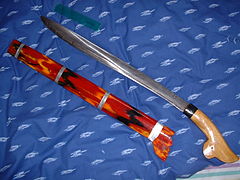- Parang (knife)
-
The parang is the Indonesia equivalent of the machete. Typical vegetation in South East Asia is more woody than in South America and the parang is therefore optimized for a stronger chopping action with a heavier blade and a "sweet spot" further forward of the handle, the blade is also beveled more obtusely to prevent it from binding in the cut. This is the same rationale and (in practical terms) the same design as the Indonesian golok and very similar to the Filipino bolo. A parang blade is usually 30 centimetres (12 in) long and has a mass of no more than 0.75 kilograms (1.7 lb). The curved blade enables maximum effort to be applied when cutting timber, and the blade arrives before the knuckles, so giving them protection. A parang has three different edges, the front is very sharp and used for skinning, the middle is wider and used for chopping, and the back end (near the handle) is very fine and used for carving.
Uses
Like the machete, the parang is frequently used in the jungle as well as being a tool for making housing, furniture, and tools. The parang has been noted in John "Lofty" Wiseman's SAS Survival Handbook, a leading survival book[1] for this use.
Parang are also used as weapons, typically carried by gang members and robbers in Malaysia. Also usedby Bear Gryllis in man versus wild.
References
Categories:- Knives
- Machetes
Wikimedia Foundation. 2010.

